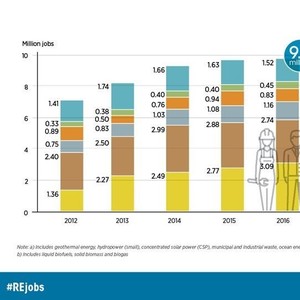Renewable energy jobs push 10 million globally




International Renewable Energy Agency
May 24, 2017
BY Anna Simet
The renewable energy industry directly and indirectly employed 9.8 million people worldwide in 2016, an increase of 1.1 percent over the previous year.
That’s according to the International Renewable Energy Agency’s newly released, annual jobs report that illustrates the state of employment in renewables by sector and leading countries.
Employment has grown each year since the first jobs report was released five years ago, according to IRENA, but has slowed a bit during the past two years.
Advertisement
Advertisement
Excluding large hydropower, renewable jobs grew 2.8 percent from 2015 to 2016, to 8.3 million jobs. Solar PV and wind have experienced the most consistent increase, doubling since 2012.
In bioenergy, liquid biofuels, solid biomass and biogas were also major employers, with 1.7 million, 0.7 million and biogas 0.3 million jobs, respectively. Positions are concentrated in feedstock supply, though labor productivity and mechanization of feedstock harvesting in some countries, such as the U.S. and Brazil, are lowering agricultural labor requirements. Solar PV and wind is seeing a similar trend, with increased automation in manufacturing and operation and maintenance reducing labor requirements.
Brazil, China, the U.S. and India were key bioenergy job markets, according to the report, which noted that the presence of a stable, favorable policy framework remains a key factor for renewable energy job creation.
Advertisement
Advertisement
For U.S. bioenergy and biofuels, ethanol production was up more than 3 percent in 2016, though employment declined by 2 percent to about 222,500 jobs, reflecting rising labor productivity, according to the report. Biodiesel production increased by 23 percent in 2016, resulting in 61,100 jobs in the sector, a 23 percent increase over last year.
New U.S. solid biomass and biogas capacity was around 131 MW in 2016. An employment-factor based calculation, the report said, suggests that direct and indirect employment in solid biomass might be close to 80,000, and the construction and operations of biogas plants may have supported around 7,000 jobs last year.
The report also pointed out that while the rate of growth of jobs in renewable energy—which creates more jobs than fossil fuel technologies, on average—has been moderate for the past two years, the trend remains positive in contrast to some countries’ traditional energy industries, which have been facing employment cuts, due to rising automation in extraction, overcapacity, industry consolidation, regional shifts, and the substitution of coal by natural gas in the power sector.
Related Stories
The U.S. Department of Energy Bioenergy Technologies Office (BETO) announced up to $23 million in funding to support research and development (R&D) of domestic chemicals and fuels from biomass and waste resources.
The U.S. DOE has announced its intent to issue funding to support high-impact research and development (R&D) projects in two priority areas: sustainable propane and renewable chemicals and algal system cultivation and preprocessing.
Sens. Sherrod Brown, D-Ohio, and Pete Ricketts, R-Neb., in August introduced the Renewable Chemicals Act, a bill that aims to create a tax credit to support the production of biobased chemicals.
The Chemical Catalysis for Bioenergy Consortium, a consortium of the U.S. DOE’s Bioenergy Technologies Office, has launched an effort that aims to gather community input on the development of new biomass processing facilities.
USDA on March 8 celebrated the second annual National Biobased Products Day, a celebration to raise public awareness of biobased products, their benefits and their contributions to the U.S. economy and rural communities.
Upcoming Events










